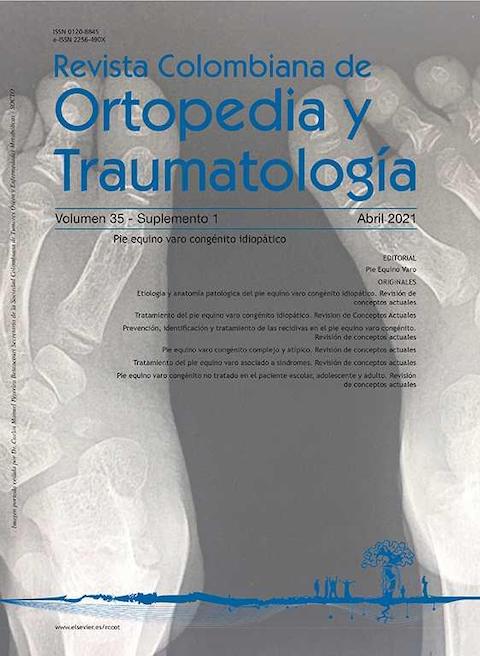Pie equino varo congénito complejo y atípico. Revisión de conceptos actuales
DOI:
https://doi.org/10.1016/j.rccot.2020.12.001Palabras clave:
pie equino varo, talipes equinovarus, etiología, factores de riesgo, anatomía patológica, genéticaResumen
El pie equino varo congénito (PEVC) atípico y complejo tiene características particulares tanto en su fisiopatología, presentación clínica como en su manejo. Su diagnóstico y tratamiento deben ser oportunos, de lo contrario pueden presentarse complicaciones en la piel, acentuación de las deformidades e inestabilidad en la articulación de Lisfranc, entre otras, lo que conduce a malos resultados. Una vez se identifica un pie complejo o atípico se recomienda implementar el Método de Ponseti (MP) modificado, descrito para el tratamiento de estas condiciones. La principal modificación al método consiste en una maniobra en la que las cabezas de los metatarsianos se empujan en bloque hacia el dorso para producir estiramiento de la fascia plantar, mientras se evitan la dorsiflexión del tobillo y una abducción excesiva. Esta posición debe mantenerse tanto en el yeso como en la férula de abducción postoperatoria. Las características de estos pies hacen que las manipulaciones y el enyesado sean exigentes, por lo que se recomienda que este tratamiento lo lleve a cabo personal adecuadamente entrenado en el MP y su modificación para pie complejo. Luego de la corrección es necesario un seguimiento estricto y prolongado, pues la probabilidad de recidiva y requerimiento de reintervenciones es mayor al descrito para el PEVC idiopático típico. Los buenos resultados obtenidos con el MP en diversas situaciones clínicas aplican para los casos de recidiva de pies atípicos y complejos; es decir, el MP modificado permite corregir las deformidades sin tener que recurrir a cirugías extensas. En esta revisión se describen en detalle las características y el tratamiento de estas variedades de PEVC.
Nivel de Evidencia: IV
Descargas
Referencias bibliográficas
Ponseti IV, Zhivkov M, Davis N, Sinclair M, Dobbs MB, Morcuende JA. Treatment of the complex idiopathic clubfoot. Clin Orthop Relat Res. 2006;451:171-6, https://doi.org/10.1097/01.blo.0000224062.39990.48
Ponseti International Association, The University of Iowa, Iowa City, IA U. Clinical Practice Guidelines for the Management of Clubfoot Deformity Using the Ponseti Method. http://www.ponseti.info/publications-resources.html.
Turco V. Recognition and management at the atypical idiopathic clubfoot. In: The Clubfoot. The Present and View of the Future. Simons G, editor. New York:Springer- Verlag. 1994. 76-77. https://doi.org/10.1007/978-1-4613-9269-9_13
Mandlecha P, Kanojia RK, Champawat VS, Kumar A. Evaluation of modified Ponseti technique in treatment of complex clubfeet. J Clin Orthop Trauma. 2019;10:599-608, https://doi.org/10.1016/j.jcot.2018.05.017
Allende V, Paz M, Sanchez S, Lanfranchi L, Torres-Gomez A, Arana E, Nogueira M, Masquijo J. Complex clubfoot treatment with ponseti method: A Latin American multicentric study. J Pediatr Orthop. 2020;40:241-5, https://doi.org/10.1097/BPO.0000000000001469
Dragoni M, Gabrielli A, Farsetti P, Bellini D, Maglione P, Ippolito E. Complex iatrogenic clubfoot: ¿Is it a real entity? J Pediatr Orthop B. 2018;27:428-34, https://doi.org/10.1097/BPB.0000000000000510
Atypical Club Foot. POSNA [Internet]. https://posna.org/Physician-Education/Study-Guide/AtypicalClub-Foot.
van Praag VM, Lysenko M, Harvey B, Yankanah R, Wright JG. Casting is effective for recurrence following Ponseti treatment of clubfoot. J Bone Joint Surg Am. 2018;100:1001-8, https://doi.org/10.2106/JBJS.17.01049
Agarwal A, Gupta S, Rastogi P. Hallux length and deep medial crease in complex clubfeet: Do they recover? J Clin Orthop Trauma. 2020;11:453-6, https://doi.org/10.1016/j.jcot.2020.03.004
Ponseti I. Congenital Clubfoot. Fundamentals of treatment. 2nd ed. New York: Oxford; 1996.
Hicks J. The mechanics of the foot II. The plantar aponeurosis and the arch. J Anat. 1954;88:25-30.
Moon DK, Gurnett CA, Aferol H, Siegel MJ, Commean PK, Dobbs MB. Soft-tissue abnormalities associated with treatment-resistant and treatment-responsive clubfoot: Findings of MRI análisis. J Bone Joint Surg Am. 2014;96:1249-56, https://doi.org/10.2106/JBJS.M.01257
Dobbs MB, Rudzki JR, Purcell DB, Walton T, Porter KR, Gurnett CA. Factors Predictive of Outcome After Use of the Ponseti Method for the Treatment of Idiopathic Clubfeet. J Bone Joint Surg Am. 2004;86:22-7, https://doi.org/10.2106/00004623-200401000-00005
Dobbs MB, Walton T, Gordon JE, Schoenecker PL, Gurnett CA. Flexor digitorum accessorius longus muscle is associated with familial idiopathic clubfoot. J Pediatr Orthop. 2005;25:357-9, https://doi.org/10.1097/01.bpo.0000152908.08422.95
Jose Jerome JT. Aberrant Tendo-Achilles Tendon in Club Foot: A case report. The Foot & Ankle Journal. 2009;2:2, https://doi.org/10.3827/faoj.2009.0202.0002
Shaheen S, Mursal H, Rabih M, Johari A. Flexor digitorum accessorius longus muscle in resistant clubfoot patients: introduction of a new sign predicting its presence. J Pediatr Orthop B. 2015;24:143-6, https://doi.org/10.1097/BPB.0000000000000129
Matar HE, Beirne P, Bruce CE, Garg NK. Treatment of complex idiopathic clubfoot using the modified Ponseti method: Up to 11 years follow-up. J Pediatr Orthop B. 2017;26:137-42, https://doi.org/10.1097/BPB.0000000000000321
Agarwal A, Gupta S, Sud A, Agarwal S. Results of Modified Ponseti Technique in Difficult Clubfoot and a review of literature. J Clin Orthop Trauma. 2020;11:222-31, https://doi.org/10.1016/j.jcot.2019.05.003
Göksan SB, Bursali A, Bilgili F, Sivacio-lu S, Ayano-lu S. Ponseti technique for the correction of idiopathic clubfeet presenting up to 1 year of age. A preliminary study in children with untreated or complex deformities. Arch Orthop Trauma Surg. 2006;126:15-21, https://doi.org/10.1007/s00402-005-0070-9
Simons GW. A Standardized Method for the Radiographic Evaluation of Clubfeet. Clin Orthop Relat Res. 1978;135: 107-18. https://doi.org/10.1097/00003086-197809000-00025
Pirani, S., Dietz F., Morcuende J., Mosca V., Herzenberg J., Weinstein S., Norgrove P., Steenbeek M. Pie Zambo: El método de Ponseti. Global-HELP Publication. http://www.ponseti.info/publications-resources.html.
Desai S, Aroojis A, Mehta R. Ultrasound Evaluation of Clubfoot Correction During Ponseti Treatment A Preliminary Report. J Pediatr Orthop. 2008;28:53-9, https://doi.org/10.1097/bpo.0b013e31815a60a6
Bhargava S, Tandon A, Prakash M, Arora S, Bhatt S, Bhargava S. Radiography and sonography of clubfoot: A comparative study. Indian J Orthop. 2012;46:229-35, https://doi.org/10.4103/0019-5413.93675
Rampal V, Rohan PY, Pillet H, Bonnet-Lebrun A, Fonseca M, Desailly E. Combined 3D analysis of lower-limb morphology and function in children with idiopathic equinovarus clubfoot: A preliminary study. Orthop Traumatol Surg Res. 2020;106:1333-7, https://doi.org/10.1016/j.otsr.2019.11.013
Ko KR, Shim JS, Kim JH, Cha YT. Difficulties During Ponseti Casting for the Treatment of Idiopathic Clubfoot. J Foot Ankle Surg. 2020;59:100-4, https://doi.org/10.1053/j.jfas.2019.07.022
Wainwright AM, Auld T, Benson MK, Theologis TN. The classification of congenital talipes equinovarus. J Bone Joint Surg Br. 2002;84:1020-4, https://doi.org/10.1302/0301-620X.84B7.12909
Eidelman M, Kotlarsky P, Herzenberg JE. Treatment of relapsed, residual and neglected clubfoot: Adjunctive surgery. J Child Orthop. 2019;13:293-303, https://doi.org/10.1302/1863-2548.13.190079
Morcuende JA, Dolan LA, Dietz FR, Ponseti IV. Radical Reduction in the Rate of Extensive Corrective Surgery for Clubfoot Using the Ponseti Method. Pediatrics. 2004;113:376-80, https://doi.org/10.1542/peds.113.2.376
Sangiorgio SN, Ebramzadeh E, Morgan RD, Zionts LE. The Timing and Relevance of Relapsed Deformity in Patients with Idiopathic Clubfoot. J Am Acad Orthop Surg. 2017;25:536-45, https://doi.org/10.5435/JAAOS-D-16-00522









